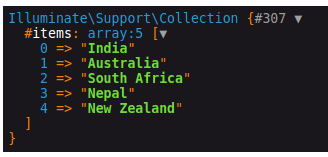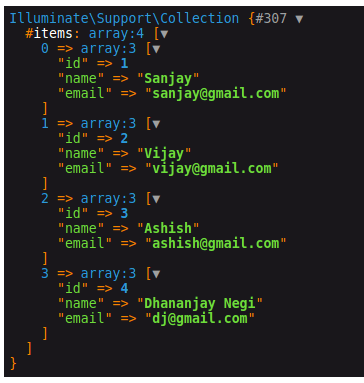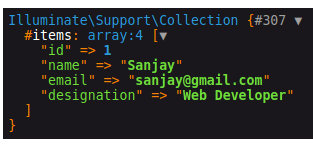Inside this article we will see the use of push() and put() methods in laravel 9 collections. Article contains a very classified information about the basic concept of Laravel 9 Collection push() and put().
We will see the concept of adding items into laravel collection. We will add into single dimensional array, multi dimensional array.
The <strong>Illuminate\Support\Collection</strong> class provides a fluent, convenient wrapper for working with arrays of data. For example, check out the following code. We’ll use the <strong>collect</strong> helper to create a new collection instance from the array.
As mentioned above, the collect helper returns a new <strong>Illuminate\Support\Collection</strong> instance for the given array.
So, creating a collection is as simple as:
$collection = collect([1, 2, 3]);Learn More –
- Laravel 9 Collection count() and countBy() Methods
- Laravel 9 Collection filter() Method Tutorial
- Laravel 9 Collection first() and firstWhere() Methods
- Laravel 9 Collection Get First and Last Item Tutorial
Let’s get started.
Laravel Installation
Open terminal and run this command to create a laravel project.
composer create-project laravel/laravel myblogIt will create a project folder with name myblog inside your local system.
To start the development server of laravel –
php artisan serveURL: http://127.0.0.1:8000
Assuming laravel already installed inside your system.
Collection push() Method
We will see how to use push() into collection.
Suppose we have SiteController.php a controller file inside /app/Http/Controllers folder.
Code Example #1
Laravel Collection push() with single dimensional array.
<?php
namespace App\Http\Controllers;
use Illuminate\Http\Request;
class SiteController extends Controller
{
public function index()
{
$collection = collect([
"India",
"Australia",
"South Africa",
"Nepal"
]);
$collection->push("New Zealand");
$collection->all();
dd($collection);
}
}
Concept
$collection->push("New Zealand");Output

Code Example #2
Laravel Collection push() with multi dimensional array.
<?php
namespace App\Http\Controllers;
use Illuminate\Http\Request;
class SiteController extends Controller
{
public function index()
{
$collection = collect([
["id" => 1, "name" => "Sanjay", "email" => "sanjay@gmail.com"],
["id" => 2, "name" => "Vijay", "email" => "vijay@gmail.com"],
["id" => 3, "name" => "Ashish", "email" => "ashish@gmail.com"]
]);
$collection->push(['id' => 4, 'name' => 'Dhananjay Negi', 'email' => 'dj@gmail.com']);
$collection->all();
dd($collection);
}
}
Concept
$collection->push(['id' => 4, 'name' => 'Dhananjay Negi', 'email' => 'dj@gmail.com']);Output

Collection put() Method
We will see how to use put() into collection. It used to add a new key value pair to collection data.
Suppose we have SiteController.php a controller file inside /app/Http/Controllers folder.
<?php
namespace App\Http\Controllers;
use Illuminate\Http\Request;
class SiteController extends Controller
{
public function index()
{
$collection = collect([
"id" => 1,
"name" => "Sanjay",
"email" => "sanjay@gmail.com"
]);
$collection->put('designation', 'Web Developer');
$collection->all();
dd($collection);
}
}
Concept
$collection->put('designation', 'Web Developer');Output

We hope this article helped you to Laravel 9 Collection push() and put() Methods Tutorial in a very detailed way.
If you liked this article, then please subscribe to our YouTube Channel for PHP & it’s framework, WordPress, Node Js video tutorials. You can also find us on Twitter and Facebook.
Read more